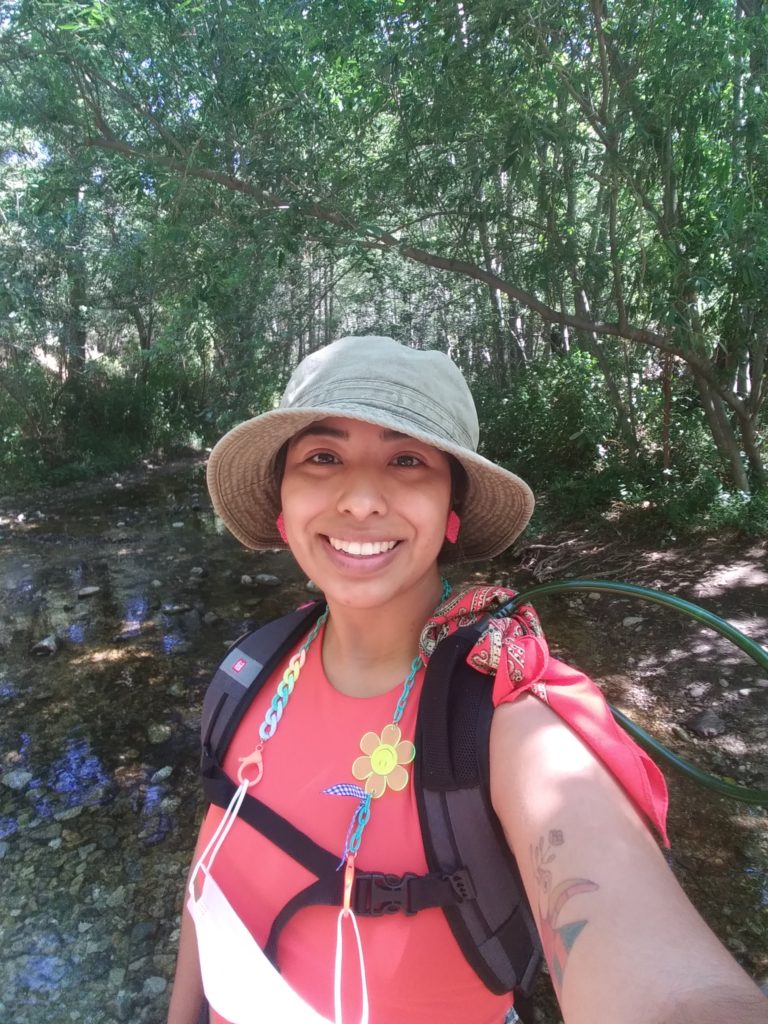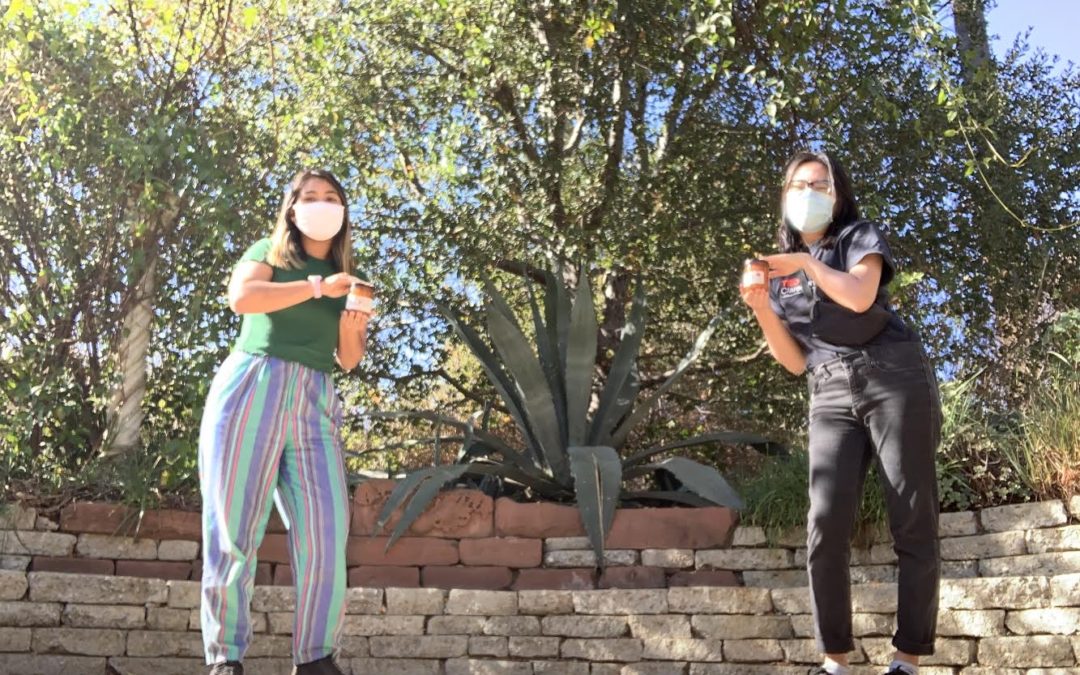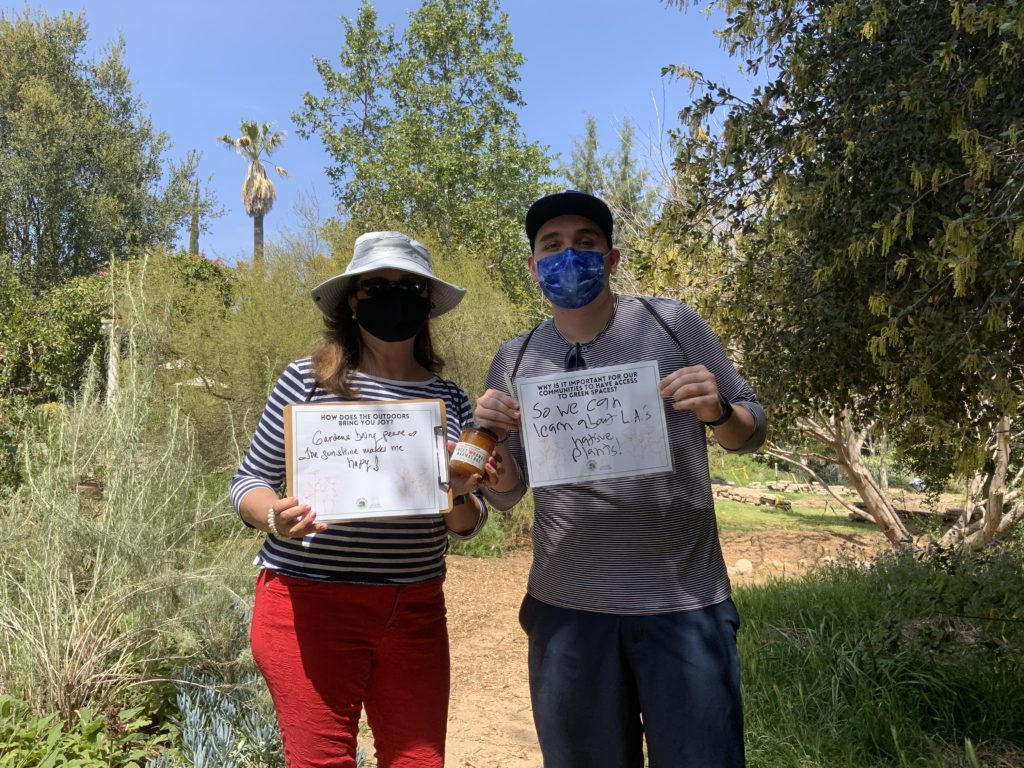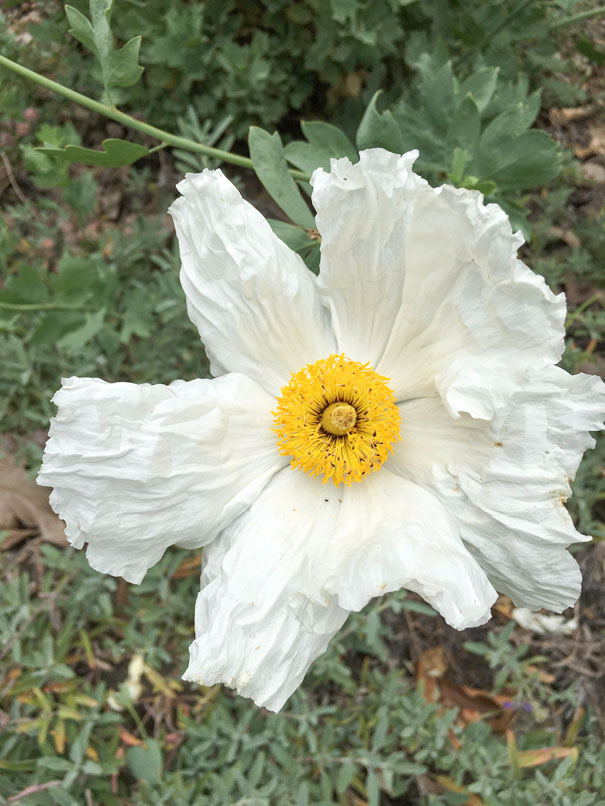Evellyn Rosas and Krystle Yu are members of the LA Nature for All Leadership Academy 2020 cohort. As part of their final project for LA Nature for All, they designed and implemented a digital audio tour for Arlington Garden that you can access here. In this interview, we talk with Evellyn Rosas about the tour, her inspirations, her relationship with nature, and how she is working to promote inclusion in outdoor and conservation circles.
AG: Evellyn, can you tell us a little bit about your background and how it might have led you to LA Nature for All?
Hello, my name is Evellyn Rosas, and I was born and raised in the San Fernando Valley. Since I started living in the San Gabriel Valley about three years ago, the natural surroundings provide a balance in my life. I enjoy finding ways to advocate for people or places that I love by searching for resources online or hearing from friends.
I happened to see the Fall 2020 Leadership Academy application through an Instagram story, so I thought, “If this training is specifically for BIPOC (Black, Indigenous, people of color) interested in environmental protection, I should try it since I identify as a person of color. “If not me, then who? If not now, when?”
The opportunity appeared at the right time when I needed a connection to people and nature during the Covid-19 pandemic.
 AG: You and your partner Krystle Yu were both part of the 18th Cohort of LA Nature for All Leadership Academy. What is the Leadership Academy? What is its overarching goal or purpose?
AG: You and your partner Krystle Yu were both part of the 18th Cohort of LA Nature for All Leadership Academy. What is the Leadership Academy? What is its overarching goal or purpose?
The Nature for All Leadership Academy is a leadership training program where Los Angeles community members learn to organize for the environmental protection and enhancement of our mountains, forests, rivers, parks, and urban open spaces. For more information about Nature for All’s mission and programs, you can also visit lanatureforall.org.
To combine what we learned in the Academy, we were asked to organize a community engagement project. Krystle and I combined our ideas to develop a project that advocated for protecting urban green space(s) in Pasadena. Based on the 2016 Los Angeles Countywide Parks and Recreation Needs Assessment, we learned how much of the Pasadena population has accessibility to parks, recreation, and open spaces. Arlington Garden happened to be the ONLY public garden in Pasadena that was still community-supported and open during the pandemic.
Our Leadership Academy Coordinator, Araceli Hernandez, helped us connect with Paloma Avila to share our project ideas. We wanted to address how people can enjoy the Garden safely while still learning how to conserve its beauty and purpose. Krystle and I began volunteering in early 2021 and loved hearing everyone’s experiences which inspired the tour details and nature journal we collaborated on.
AG: Can you talk about the tours (both the self-guided tour and the guided tour) that you did for Arlington Garden? What goal did you have in creating the tours?
The tours and nature journal activities help participants understand the importance of nature conservation and access to green spaces. More specifically, we provided learning tools for the community to learn about Arlington Garden’s regenerative gardening practices, climate-specific native plants, and how plants benefit our well-being. On April 6, we hosted the in-person tours with Garden Staff Levi Brewster, Paloma Avila, and Maggie Smart-McCabe. They each led and interacted with guests through various spaces such as the Pomegranate Amphitheater, Native Wildflower Garden, and Pine Forest, to name a few. Those same spaces were reflected in a written and audio self-guided tour for folks to use any other day through the izi.travel phone application. We included the voices from the Staff and Volunteers because they made the storytelling more fun and personal! If you haven’t listened to the tour, please check it out here.
Through a photo campaign and our nature journal, we asked tour participants to reflect on their relationship to nature and the importance of green space accessibility. We had a great turnout! We welcomed about 30 people on the day of the event, each from a different background, age group, and varying levels of knowledge in gardening. Lastly, the nature journal PDF is available for you to download here so you can interact with the tour or use it as a stand-alone guide. With everyone’s support from the garden and our Nature for All team, our project was a success!
AG: You collaborated on this project — what brought you and Krystle together as a pair to work on it? Did you learn anything from each other?
Most of our cohort meetings were hosted online because of the pandemic. Luckily, our coordinator helped connect us because our project ideas consisted of working with youth and families and outdoor education. Krystle was one of the first people I consistently saw in person from my cohort, and it helped us grow together as a team. We learned that by sharing the responsibility of the project, we had to be accountable to each other and, most importantly, to ourselves. Since this project challenged our professional and personal skills, we learned to be flexible and transparent about our capacity to chat, work, or meet at the Garden.
AG: Your tours are clearly designed to be inclusive of a diverse audience. Can you talk about what you did to make them inclusive and why that is important to you?
We aspired to make our nature journal, tours, and promotional Instagram page @naturerelations multilingual (English, Spanish, and Mandarin) to honor our cultural backgrounds and include our communities who know the languages. Krystle speaks Mandarin in her family home, as I speak Spanish in mine. When some vocabulary didn’t translate as easily in Spanish and Mandarin, we would ask for family help or consult a dictionary. Our families learned alongside us while they helped us translate concepts into digestible/accessible language for our audiences.
I work a lot with Spanish-speaking families so I wanted to make sure they can participate in the tours. We also made sure our journal can be used by most ages to practice their creativity and critical thinking. It’s not often that we see outdoor education explained in Spanish or Mandarin, so this was a milestone for us to create. Regardless of language, we knew people would appreciate the activity to bond together and learn about Arlington Garden so that they feel empowered to use their voices to continue protecting urban green spaces like Arlington Garden.
AG: What is your own (personal) relationship to gardens and green or “wild” or natural spaces (by “wild spaces” I mean spaces with intact ecosystems)?
My mom’s side of the family grew up in Mexico, tending to the land and animals at a young age. Because of their expertise being passed down generations, I learned to connect with gardening at a young age.
I didn’t appreciate all the beauty of gardening until I moved back from college and had the time or space to start planting seeds. First, I learned to grow vegetables and fruits – tomatoes, broccoli, peppers, squash, apples, potatoes – and now I’m working on growing flowers and native plants. Volunteering at Arlington Garden has provided me with the most up-to-date knowledge on maintaining and allowing a green space to grow how it pleases. My favorite part about Arlington Garden is that I remember the names of plants when I see one on hiking trails or in another garden.
AG: What is something that you find fascinating about the natural world or the plant communities around Los Angeles County?
We lost about 115,796 acres of the San Gabriel Mountains during the Bobcat Fire. Thinking back to those months, I remember feeling grief I couldn’t explain, but I know most of us experienced it. Fast forward to July. I recently drove down the 2 Highway from a camping trip when I noticed green bushes and plants growing along the burnt mountains. The charred trees still stood tall, with new plant growth to show us some hope that the vegetation will regenerate. They rose from the ashes!!
AG: What’s your favorite spot in Arlington Garden?
The native wildflower area in bloom feels like I walked into a fairytale. Each time I visit, a new flower bloomed, or more bees and butterflies appear. It’s gorgeous and mesmerizing to take in. You can tell that the garden is loved for it to provide this type of beauty in return.
AG: Do you have any book, article, or film recommendations for the members of the Arlington Garden community?
In addition to the 2016 Los Angeles Countywide Parks and Recreation Needs Assessment I mentioned above, I’d recommend folks watch the KCET documentary “Tending the Wild.” From the KCET website, an excerpt reads:
“Tending the Wild” shines light on the environmental knowledge of Indigenous Peoples across California by exploring how they have actively shaped and tended the land for millennia, in the process developing a deep understanding of plant and animal life.”
The documentary reminds us that Indigenous Peoples are still denied their right to defend and cultivate on land that was stolen from them during colonization. After watching, I suggest taking an opportunity to reflect on how we can be in solidarity with Indigenous Peoples and work together to protect our environment. Please, please enjoy the wisdom that is offered in this docuseries!





Recent Comments